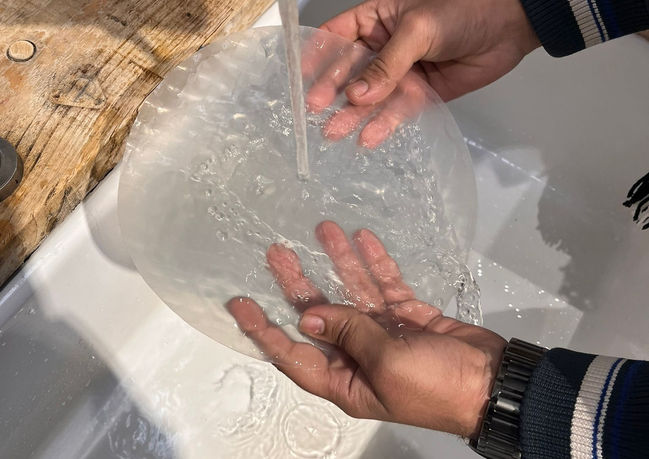top of page

UX of Paper
25 Nov - 9 Nov
Design Breif
Design an experience of paper that explores its material, cultural and emotional qualities
Back To Top
Team

WEEK 1
Feeling love & the art of hidden messages
The history of love letters is considered to begin in the renaissance age. While in the early 19th century, it became purer. This time produced Beethoven's great private love letters to his "Immortal Beloved" and the literary romance of poets Robert Browning and Elizabeth Barrett. In the modern age, we no more write letters on paper. Instead, send it on the mail or chat as a few messages burdened by thousands of other digital content over time. So we asked whether digital love letters allow you to feel love and get it soaked in your subconscious mind in the information overload age.
While the conversation about love was going on, we also looked at hidden feelings and messages. We were inspired by Spies, who have this method to exchange secret messages.
Exploring different media
During our literature review, we encountered the relationship between taste and memory. We were excited about our ability to identify a taste and relate it to past consequences of its ingestion and started wondering what if people could feel the love with the taste and recall the taste of love in their subconscious mind later. On the other hand, we had the idea of unrevealing feelings for each other using hidden messages which no one else other than them could read.
We started exploring materials and different ways to make people experience the idea. We found rice paper for the taste of love, and we had multi-flavoured edible gels. At the same time, rice paper has its challenge of resembling plastic once it is wet. Dry rice paper is not considered an excellent edible item due to its water-sucking property.
We played around with lemon; milk wrings heated up to be unrevealed.

Experience 1 - Tasting love
In this activity, we asked two participants to write their feelings for each other with milk a day prior to the presentation. Then, on the next day, they revealed their secret feelings by heating the paper with iron in front of the class.
Experience 2 - Unrevealing feelings
We asked two participants to express their feelings on the wet rice paper with multi-taste gel pens. Once they were done, they exchanged their feelings and tasted them by eating. We wanted the participants to remember feelings for each other by taste.

Week 1 Presentation

Week 1 feedback
Move your focus from love and focus more on paper
Paper is preservatory but with this you ate it and it's gone.
What other natual inridients could you use?

Bodystorming for idea generation
In week 2, we wanted to go beyond love, but we struggled with ideas, so we decided to use the bodystorming method to generate ideas. During the process, we realized paper could capture moments and preserve them for life long in the form of a memory sketchbook, photographic album, or a diary. In each of the cases, we remember old moments and feel nostalgic.
WEEK 2
Nostalgia & edible paper
We were excited about how taste could bring us into nostalgia which reminds us of events, people, and scenarios wrapped around strong emotions (Ornotopia, 2020). However, nostalgia could also bring negative emotions, and the brain could see it as taste aversion. Taste could be momentary, but it can bring out long-lasting emotional experiences. While we were brainstorming, we thought if you could have a memory book where participants could write, draw, or even add a taste of their food, take a bite, and relive the experience in their subconscious mind. Beyond rice paper, we found wafer paper that resembles the taste and other physical properties of paper this time. Wafer paper melts in the mouth as it comes in contact with your saliva, i.e. it would be tough to use liquid materials on top of it. We experimented with adding and eating paper with different edibles to test what works best.

Taste & edibles
We were excited about the idea and decided to play around with taste rather than flavours. Humans have five different taste qualities: Salty, Savoury, Sweet, Bitter, Sour (Gravina, S.A., Yep, G.L. and Khan, M., 2013). We explored edibles that resemble the respective taste based on the standard tastes.
Building our own edible memory book

Activity planned for final experience
We called participants and asked them to express their memories in their memory book with edibles resembling the five taste qualities for the activity. They were provided with an opportunity to explore their subconscious emotional memories and immerse them with the taste while expressing it on the edible paper. Later, they had to take a bite of their memory and experience the taste.

Week 2 Presentation

Week 2 feedback
You could bring variety in materials and could have find a better use of it.
Try printing on paper insted of drawing.
The color of the gels or eatables should be similar to avoid biases.
Citations
Ornotopia (2020). How the Taste of Food Bring Feelings of Nostalgia. [online] Ornatopia. Available at: https://www.ornatopia.com/food-and-nostalgia-how-your-taste-buds-take-you-back-to-the-past/.
Gravina, S.A., Yep, G.L. and Khan, M., 2013. Human biology of taste. Annals of Saudi medicine, 33(3), pp.217-222.
bottom of page












































.png)
.png)
.png)
.png)